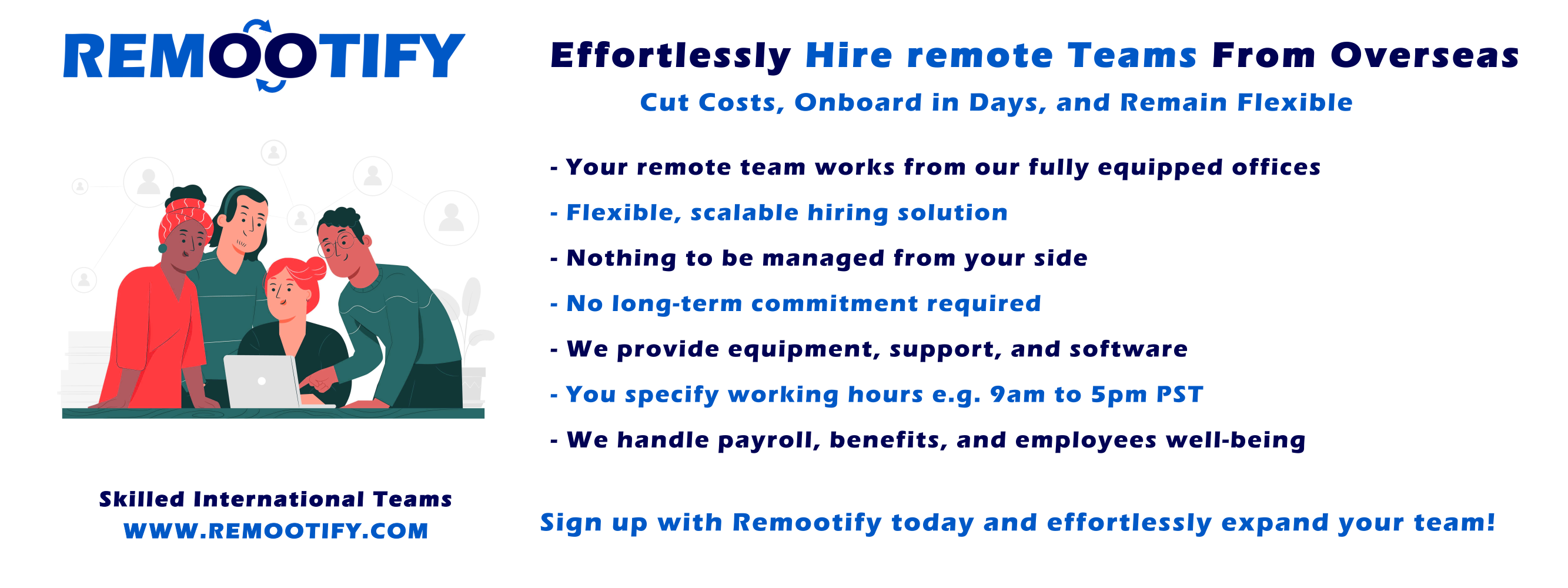Start hiring YOUR REMOTE TEAM, Today!
Enter your information below to start a discussion with one of our team members!

Welcome to our fascinating blog, where we explore the differences between distributed and remote teams and reveal the mysteries behind the future of work setups.
We’ll explore the ins and outs of these two dynamic team dynamics as we delve deeply into the fascinating world of contemporary collaborations.
Prepare to navigate the advantages, disadvantages, and minute details that make each approach distinct.
So buckle up as we unravel the dynamics of the ever-changing workplace!
Understanding Distributed Teams
In today’s professional realm, the notion of a distributed team is rapidly gaining traction. But what does it indeed entail?
According to Aircall’s definition, a distributed team is a collective of individuals operating from various locations.
The standout feature of such a team is that it lacks a central headquarters.
Members can work from any corner of the world yet remain an interconnected and cohesive unit, striving towards shared objectives and goals.
Examples of Companies with Distributed Teams
To benefit from this model, tech companies, as well as companies in almost every other sector, have been utilising distributed teams more and more.
A group of technical experts who work remotely but were all hired for their unique skill sets or knowledge bases is an example of a distributed team.
They assist clients wherever they are by using cloud-based software.
Benefits of Having a Distributed Team
Distributed teams offer several advantages:
- They reduce in-house costs.
- Businesses can grow without incurring significant new costs.
- They allow companies to hire the best talent without being limited by geography.
- They enable more accessible communication and collaboration across regions.
- They open up sales or customer service for customers over a more significant number of hours in the day.
- They offer the benefit of one team member passing off a project to another team member working on the upcoming shift.
Challenges with Distributed Teams
While distributed teams have many advantages, they also face unique difficulties:
- Processes for routine communication and collaboration must be established.
- It might not be feasible or possible to hold in-person meetings.
- Finding a convenient time to meet online can be challenging because team members may work in different time zones.
- Because nonverbal cues, such as body language and facial expressions, cannot be read during audio or video meetings, communication may not be clear.
Despite these difficulties, many businesses discover that distributed teams have more advantages than disadvantages.
Appropriate tools and procedures are key to efficient communication and collaboration.
For more insights on distributed teams, you can check out these articles:
- Distributed Teams: The Basics of Distributed Companies
- Seven best practices for a successful distributed team | Envoy
- Remote vs distributed teams: How do they differ? – Surf Office
Understanding Remote Teams
The traditional work environment has undergone a significant transformation in the wake of the global pandemic.
Thousands of companies have partially or entirely transitioned to remote work setups.
This shift has brought the concept of remote teams to the forefront of business operations.
A remote team is a group of professionals working together towards a common goal, but not necessarily from the exact physical location.
They could work from home, in a coffee shop, or even in different countries.
The essential characteristic of a remote team is that geographical constraints do not bind its members.
They can work from anywhere, with a reliable internet connection and the necessary tools to perform their tasks.
Real-World Examples
Several companies have successfully incorporated remote teams into their business models.
One such example is Buffer, a social media management platform.
Buffer has been operating as a fully remote team since 2012, with almost 100 employees working from nearly every time zone worldwide.
CEO Joel Gascoigne said the decision to go fully remote has greatly benefited the company.
He states, “I am happy to report that I am in love with the choice we made to be distributed all across the world.”
Benefits of Remote Teams
Remote teams offer a host of benefits to businesses. Here are a few key advantages:
Flexibility: Remote work allows employees to work from anywhere, offering them the freedom to travel or live in a location of their choice. This flexibility can lead to increased job satisfaction and productivity.
Access to Global Talent: With remote teams, businesses can hire the best talent from anywhere in the world without being limited by geographical boundaries.
Cost Savings: Operating a remote team can lead to significant cost savings. Businesses can reduce expenses related to office space, utilities, and commuting allowances.
Increased Productivity: Studies have shown remote workers are often more productive than their office-bound counterparts. The flexibility to work in a comfortable environment and the elimination of commute time contribute to this increased productivity.
However, it’s not all sunshine and roses.
Remote teams also come with their own challenges, such as communication issues, time zone differences, and the potential for isolation among team members.
But with the right strategies and tools in place, these challenges can be effectively managed.
For a more in-depth look at remote teams, you might find this article on Contract Recruiter helpful.
It provides a comprehensive overview of remote teams, including their benefits and drawbacks.
Remote vs Distributed: The Key Differences
While remote and distributed teams operate outside a traditional office environment, critical differences can impact how they function and collaborate.
Location of employees: In a remote team, employees can work from anywhere, but there is usually a central office where some team members or the company’s leadership is based.
In contrast, a distributed team is spread across different geographical locations, with no central office.
Access to talent: Both models allow companies to tap into a global talent pool. However, distributed teams often have a more diverse workforce as they hire people from different countries and cultures, while remote teams might still be concentrated in a few countries.
Communication and collaboration: Both teams rely heavily on digital tools for communication and cooperation.
However, distributed teams may face more challenges due to different time zones, making real-time communication difficult.
Company culture: Building a company culture can be challenging for both teams. However, it’s often more complex for distributed teams due to the geographical and cultural differences among team members.
Operational costs: Both models can help companies save on operating expenses such as office rent and utilities.
However, distributed teams might incur additional costs related to managing a global workforce, such as travel expenses for team meetups or higher prices for equal benefits to employees in different countries.
Regulatory considerations: Managing a distributed team can be more complex due to different labour countries’ laws, tax regulations, and employment contracts.
In contrast, remote teams, especially those based in one country, might have fewer regulatory issues.
| Aspect | Remote | Distributed |
|---|---|---|
| Location of employees | 🟢 | 🔴 |
| Access to talent | 🟢 | 🟢 |
| Communication | 🟢 | 🔴 |
| Company culture | 🔴 | 🔴 |
| Operational costs | 🟢 | 🔴 |
| Regulatory considerations | 🟢 | 🔴 |
It’s important to note that there’s no one-size-fits-all approach to choosing between a remote and distributed team.
The best choice depends on various factors, including the nature of your business, company goals, and the work culture you want to build.
For a more in-depth comparison, you can check out this article.
The Future of Work: A Hybrid Approach?
As we move forward, it’s clear that the future of work will not be confined to the traditional office setup.
Both remote and distributed work arrangements offer unique benefits, and companies may find that a hybrid approach works best for them.
For instance, companies may opt for a central office but offer remote work options.
This way, they can enjoy the benefits of having a physical office, such as face-to-face interactions and collaboration, while also reaping the benefits of remote work, such as increased productivity and lower overhead costs.
Ultimately, the choice between remote and distributed teams will depend on various factors, including the nature of the work, the company’s goals, and the team members’ preferences.
Frequently Asked Questions
This section answers some of the most frequently asked remote and distributed teams questions.
What is a remote team?
A remote team is a group of individuals who work together but are not physically located in the same place.
They could work from home, in a coworking space, or anywhere outside a traditional office.
What is a distributed team?
A distributed team is similar to a remote team but with one key difference: no central office exists.
All team members work remotely from different locations.
What are the benefits of remote work?
Remote work offers several benefits, including increased productivity, lower absenteeism, and cost savings for the company.
What are the benefits of distributed teams?
Distributed teams allow companies to tap into a global talent pool, foster a diverse and inclusive culture, and operate across different time zones.
Which is better – remote or distributed teams?
There’s no definitive answer to this, as it depends on various factors.
Some companies may find that remote work suits them better, while others prefer distributed teams. It’s all about finding what works best for your company and team.
Conclusion
The future of work is here, and it’s clear that it’s not confined to the four walls of an office. Whether it’s remote or distributed teams, companies have a wealth of options to choose from.
The key is to understand the unique needs and goals of your company and your team and to choose the work arrangement that best supports these needs and goals.
So, are you ready to embrace the future of work? One thing is clear whether you choose remote or distributed teams: the end of work is flexible.
And that’s something we can all look forward to.
This article was inspired by insights from Forbes, Harvard University, Global Workplace Analytics, and Stanford University.





